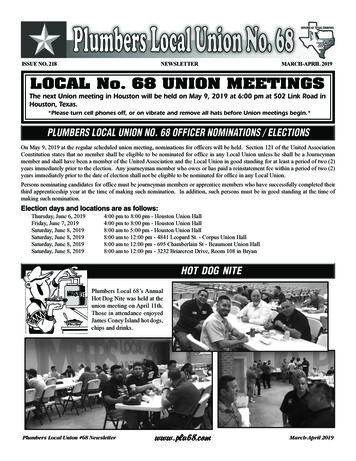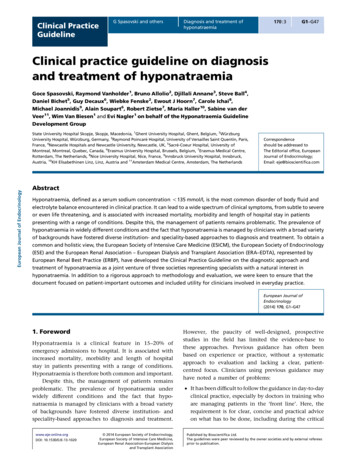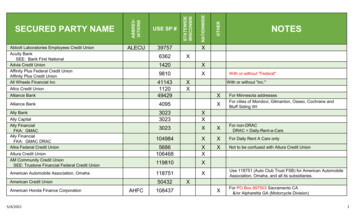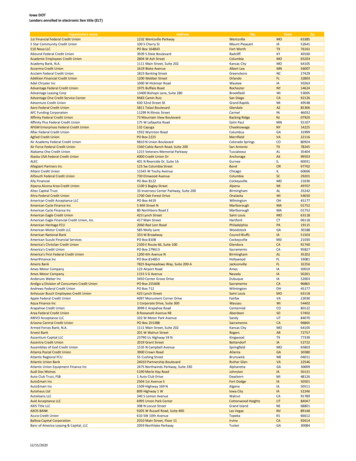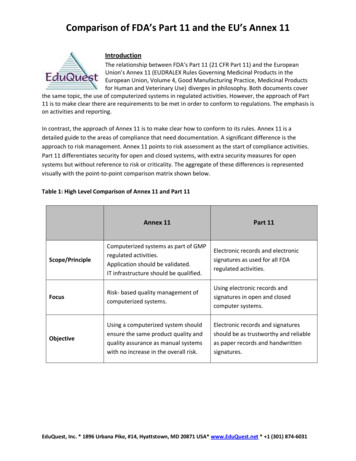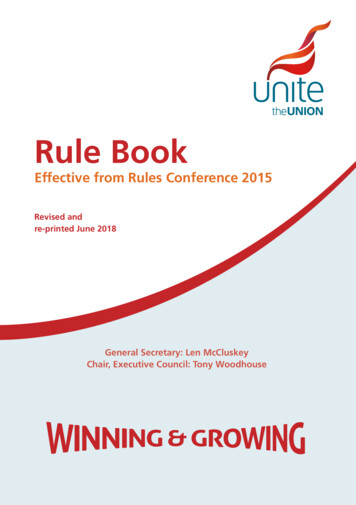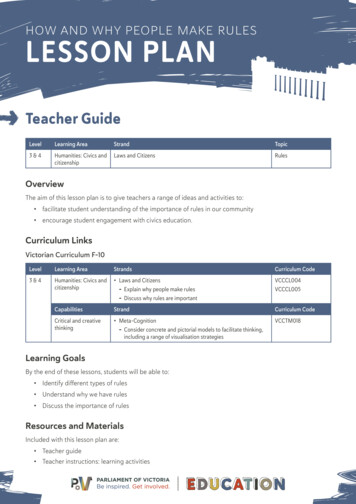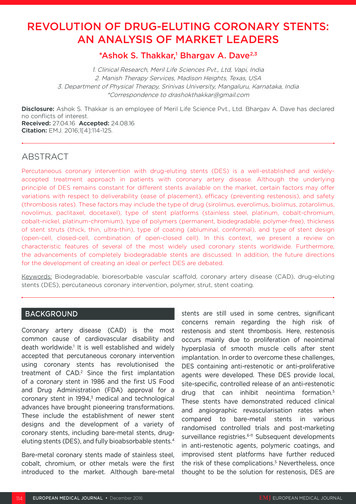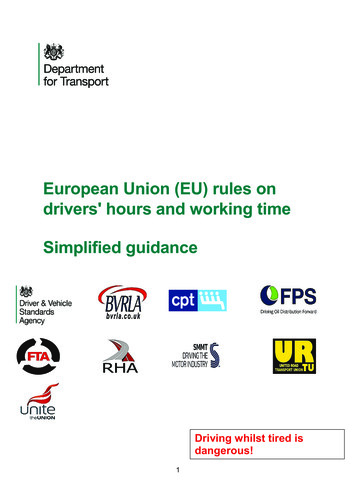
Transcription
European Union (EU) rules ondrivers' hours and working timeSimplified guidance 'ULYLQJ ZKLOVW WLUHG LV GDQJHURXV 1
IntroductionAs part of both the Logistics Growth Review and the Red Tape Challenge theDepartment for Transport agreed to work with industry to look into whether there wasscope to simplify the regime covering the EU drivers’ hours and working time, withthe aim of discussing this with other Member States and the European Commission.An industry Stakeholder Working Group was set up to look into this issue in 2013and the Group submitted its final report to the Department in January 2014 with anumber of recommendations on the way forward. A copy of the report can be viewedon the gov.uk website king-group-final-reportThe Group concluded that it would not be advisable to reopen negotiations atEuropean level on the legislation covering drivers’ hours and working time, because: there is a risk that re-opening the negotiations could take years to complete(last negotiations of the drivers’ hours regulations took five years); and there is a risk that re-opening negotiations could result in a regime that wouldbe more onerous and complex than the current regime.In addition, the Group concluded that the current problems with the regime relate toa lack of clarity and understanding of the existing rules, rather than the rulesthemselves. They decided that above all, there was a lack of understanding of whena driver needs to take a break, as the requirements in the driver’s hours rules aredifferent to those in the working time rules. Therefore, although the Group agreedthat the current guidance was comprehensive (but understandably long andcomplex), they recommend the drafting of additional simplified guides; to supplementthe current guidance (particularly covering breaks), aimed specifically at thedriver/transport manager.The Department agreed with the group’s recommended way forward and has workedwith industry and trade unions to produce this simplified guidance, which we hopewill help drivers better understand how the EU drivers’ hours and working time ruleswork together.This guidance is not a substitute for the current full guidance documents on drivers’hours and working time, which are available on the gov.uk website rs-hours-rules-and-guidance2
Table - A summary of the EU drivers’ hours rules andsector specific working time rulesDrivers’ hours rulesRegulation (EC)561/2006Working time rulesDirective 2002/15/ECDrivingWorking time (including driving) 9 hours daily driving limit (can beincreased to 10 hours twice a week)Maximum 56 hours weekly driving limitMaximum 90 hours fortnightly drivinglimitBreaks Working time must not exceed averageof 48 hours a week (no opt out)1Maximum working time of 60 hours inone week (provided average notexceeded)Maximum working time of 10 hours ifnight work performed2Breaks345 minutes break after 4.5 hoursdrivingA break can be split into two periods,the first being at least 15 minutes andthe second at least 30 minutes (whichmust be completed after 4.5 hoursdriving) Rest Cannot work for more than 6 hourswithout a break. A break should be atleast 15 minutes long30 minute break if working between 6and 9 hours in total445 minute break if working more than 9hours in totalRest11 hours regular daily rest5; which canbe reduced to 9 hours no more thanthree times a week.45 hours weekly rest, which can bereduced to 24 hours, provided at least Same rest requirements as EU drivers'hours rulesone full rest is taken in any fortnight. Thereshould be no more than six consecutive 24hour periods between weekly rests.Normally calculated over a rolling 17 week period, but can be extended to 26 weeks under a collective or workforceagreement2Can be extended under a collective or workforce agreement3EC Regulation 561/2006 is directly effective and takes precedence over EC Directive 2002/15 - Article 2.4 Directive 2002/15.Therefore, EU drivers’ hours break requirements take precedence when driving4After working for 6 hours a mobile worker must take a break of at least 15 minutes. However, if working more than 6 and upto 9 hours in a shift a mobile worker needs to take a break totalling at least 30 minutes - this could be two breaks of 15 minutes.Where a shift will contain more than 9 hours of working time, a total of 45 minutes of break is needed.5 Alternatively, this regular daily rest period may be taken in two periods, the first of which must be an uninterrupted period of atleast 3 hours and the second an uninterrupted period of at least nine hours13
Who needs to follow these rules?Drivers of goods vehicles or combinations of vehicle and trailer of more than 3.5tonnes and passenger vehicles with more than 9 seats (including the driver’s),unless covered by a specific EU-wide exemption or a national derogation. For detailson these exemptions and national derogations please see link below to DfT’spublished /drivers-hours-rules-and-guidanceWhat do the rules cover?The rules cover maximum limits on driving time, working time and minimumrequirements for breaks and rest periods.What are the tachograph modes or activity symbols?DrivingBreak or rest periodOther workPeriod of availability (POA)Why do we have two sets of rules?When the EU drivers hours rules were introduced years ago, although they restrictedthe amount of driving that could be done and the amount of minimum rest driversneeded to take, some drivers were still being expected to work long hours doingother work, in addition to driving. Therefore, it was decided at European level thatdrivers working under the EU drivers hours rules should also have restrictions on theamount of overall work (including driving) they could do.4
How many hours can I drive in one day?The rules have a daily limit on driving of 9 hours between daily/weekly rest periods.However, up to twice a week a driver can increase the maximum driving time to 10hours.How many hours can I work in one day?Although there is no daily limit on the amount of working time in one day (betweendaily/weekly rest periods), the requirements for minimum daily rest (9 hours in 24)mean a driver cannot have a working day of more than 15 hours at most three timesbetween weekly rest periods. Where a driver has a full daily rest of 11 hours, themaximum working day is 13 hours.The working day or shift spread between daily/weekly rest periods is made up oftime recorded for driving, other work, breaks and periods of availability (POA).Although working time consists of only hours recorded for driving and other work,breaks and periods of availability must be taken into account when calculating theshift spread for a driver, to ensure enough daily rest has been taken.LEGAL example of a Shift hrsDrivingBreakPOADrivingOther workBreakOtherworkThe above example shows a shift spread of 15 hours from the time the driver startedwork until completion, this would allow for a reduced rest of 9hrs within the 24 hoursfrom start of working dayILLEGAL example of a Shift hrsDrivingBreakPOADrivingOther workBreakOtherworkIn above example although there are 15 hours recorded as working time, the shiftspread is in fact 18 hours leaving only 6 hours with the 24 hours from the start of theworking day for a daily rest period, which is illegal so that the driver would becommitting an offence.5
Is there a limit on the hours I can drive/work at night in one day?Yes; under the working time rules there is a 10 hour working time limit in any 24hours if any work (including driving) is carried out during the night time period, unlessthere is a relevant agreement in place to work longer.What is classed as a ‘night time period’ and what is a relevantagreement?The night time period is between 00:00 and 04:00 for goods vehicles and between01:00 and 05:00 for passenger vehicles.A relevant agreement can be either a collective agreement (between the employerand an independent trade union) or a 'workforce agreement' (between the employerand an elected representative of the workforce).If there is a relevant agreement in place how much longer can a driverwork at night in one day?There is no limit in the working time rules. However, taking into account theminimum rest requirements, a driver cannot work for more than 15 hours in one dayup to three occasions between weekly rest periods.Example below show no more than 10 hours working time in any 24 hourperiod00:0009:004 hrs1 hr 4 hrs00:0015 hrs09:004 hrs 1 hr 4 hrs Example below shows that owing to a shorter daily rest period in the 24 hourperiod from 00:00 on day 1 to 00:00 on the second day there is 11 hours ofworking time, with this being repeated during the two days (as the 24 hrswindow moves forward and backwards)00:0009:004 hrs 1 hr4 hrs21:0012 hrs 09:006 hrs 61 hr5 hrs
How many hours can I drive in one week?Over a week, you can drive for a maximum of 56 hours in total (e.g. 9 hours on 4days, and 10 hours on 2 days) although over two consecutive weeks you must notexceed 90 hours.Total hrs in fortnight 92IllegalWeek 1Week 2Week 3Week 443 hours driving46 hours driving46 hours driving38 hours drivingTotal hrs in fortnight 89Total hrs in fortnight 84LegalLegalRemember to check both forward and backwards when calculating fortnightlydriving hoursWhat is classed as a week?A ‘week’ means the period of time between 00.00 on Monday and 24.00 on Sunday.However, for recording purposes this would be 00.01 Monday to 23.59 Sunday.How many hours can I work in one week?You may not exceed an average of 48 hours working time (driving and other work)per week over a specific reference period. In addition you must not work for morethan 60 hours in any single week.What is a reference period?Normally, the number of hours worked each week should be averaged out over acontinuous 17 week period. However, this period can be extended to 26 weeks ifthere is a relevant agreement in place. This continuous 17 to 26 week period is usedto calculate the average weekly working time and is known as the 'reference period'.A reference period starts at 00:01 on Monday and runs for the relevant number ofweeks until 24:00 on Sunday. If the 17 week reference period is selected there will7
be one period of 18 weeks to cover the year. The default 17 week reference periodsstart on the first Monday of April, August and December.If I don’t do that much driving in a day, do I still need to comply withthe rules?Even a short period of driving under EU drivers’ hours rules during any day meansyou are in scope of the EU drivers’ hours and working time rules and will need tocomply with all the rules on driving, break and rest requirements for that day andweekly rest requirements for that week.However, drivers who only occasionally drive vehicles under the EU drivers’ hoursrules would be exempt from the working time rules - by occasionally we mean: they only drive for 10 days or less under the EU drivers' hours rules in areference period that is shorter than 26 weeks;they only drive for 15 days or less under the EU drivers' hours rules in areference period that is 26 weeks long.What breaks do I need to take in one day?This will depend on whether you are driving or doing other work. If you are driving,under the EU drivers’ hours rules you must take 45 minutes of break time once youhave driven for 4.5 hours in a day. A driver can take a split break of at least 15minutes followed by another of at least 30 minutes (in that order). Once the 45minute break has been completed a further 45 minutes break will need to be taken ifa further 4.5 hours of driving is completed.If you are doing other work, under the working time rules you will need to take abreak or breaks totalling 30 minutes, if working a total of between 6 and 9 hours in ashift. If working for more than 9 hours you will need to take a break totalling 45minutes. All working time breaks can be split into periods of at least 15 minutes.A driver must not work (including driving) for more than 6 hours without a break.8
Do I need a break yet?Have you driven for4.5 hours?YesNoHave you accumulated 4.5 hours of driving?Take a 45minute breakYesNoHave you alreadyhad any breaks?YesYesNoTake aminimumbreak of 15minutesTake a 45minutebreakWas the breakless than 45minutes?YesNoWas thebreak at least15 minutes?Recalculatefrom the end oflast breakalready hadany breaks?YesHave you done 6hours of work?NoTake a 30 minutebreakTake a 45 minutebreak9NoNo breakrequired yet
Why are the driving and working time breaks different?Driving a large vehicle is more difficult and carries more risk than other types ofwork, that is why the break requirements in the drivers’ hours rules are tighter thanthose in the working time rules.When will I know what break I need to have; if I drive and do otherwork in one day?When you are driving you need to keep in mind the drivers’ hours rules and take abreak of 45 minutes when you have driven for 4.5 hours. However, if you do otherwork before driving this will count towards your working time, so you must rememberthat you must never work (including driving) for more than 6 hours without a break. Inother words take a break after no more than 4.5 hours of driving or 6 hours of work,which ever happens soonest.What is classed as a break?A break is any period of time during your working day when you are not carrying outany driving or any other work. This time must be used just to relax and recuperate.Can I take my break in my vehicle?Yes, as long as you are not doing any other work and are using the time torecuperate.Break Examples:Driving only - with a single break4.5 hrs driving45 minutes break4.5 hrs drivingAfter 4.5 hours of driving a driver MUST take a break, here the driver take a full 45minutes break before continuing to drive.Driving only - with split break2.5 hrs15 mins2 hrs30 mins4.5 hrsDrivingBreakDrivingBreakDrivingUsing a split break the driver takes a minimum of 15 minutes after 2.5 hours ofdriving and then having completing 4.5 hours of driving (by driving a further 2 hours),the remainder of the break is taken with a break of a minimum of 30 minutes10
Driving and other work not exceeding 6hrs of combined working between EUdriving breaks4 hrs1.5 hrs45 mins3 hrs2 hrsDrivingOther workBreakDrivingOther workHere the driver has not driven more than 4.5hrs without the 45 minute break; thedriver has not worked (driving and other work) for more than 6 hours without a break.Total number of worked hours is 10.5 hours which requires a working time break ofat least 45 minutes, which has been achievedDriving and other work with split breaks used to satisfy EU working time breakrequirements4 hrs2 hrsDrivingOther work15minsBreak1.5 hrs30minsOther workDriving30minsBreak4.5 hrsDrivingHere the driver has not completed 4.5hrs driving but after 4 hours of driving started3.5 hours of other work. After completing 2 hours of other work the driver hadreached 6 hours of working time so was due a minimum break of 15 minutes. After afurther 1.5 hours of other work the driver drove for 30 minutes thereby completing4.5 hours of driving and was then required to complete the 45 minutes of break dueunder EU drivers hours by taking a further 30 minutes, having already taken 15minutes using the split break rule. The driver was then able to complete a further 4.5hours of drivingWhat rest do I need to take in one day?You must take at least 11 continuous hours of rest. However, this daily restrequirement can be reduced to 9 hours up to three times between weekly restperiods.Are there any other flexibilities on daily rest?Yes; you can: take a split daily rest of at least 3 hours followed by another of at least 9 hours(totalling 12 hours). There is no limit to the number of split daily rest periodsthat can be taken;On a train or ferry crossing, interrupt your daily rest up to two times for a totalamount of 1 hour, but you must have access to a bunk or couchette. This canonly be done when a regular daily rest period is taken and the rest time muststill total 11 hours.If two or more drivers operate a vehicle, each driver must have a daily restperiod of at least 9 consecutive hours within 30 hours of the last daily or11
weekly rest period (this will however count as a reduced daily rest period forboth drivers). This allows drivers' duties to be spread over 21 hours. Themaximum driving time for a two-man crew using this allowance is 20 hours, ifboth drivers are entitled to drive for ten hours. After this time, a daily rest isrequired.Can I take my daily rest in my vehicle?Yes, you can take your daily rest period or a reduced weekly rest period in yourvehicle, provided the vehicle is stationary and is fitted with suitable sleeping facilities.However, you cannot take a regular weekly rest period in your vehicle.Regular daily rest13 hrs work (driving, other work, periods ofavailability and breaks) 11 hrs rest (full daily rest) Reduced daily rest15 hrs work (driving, other work, periods ofavailability and breaks) 9 hrs rest (reduced daily rest) Both of the above examples show a full 24 hours from the start of the working day tothe completion of the working day, including the daily rest period. It is howeverpossible to have a shorter working day and a daily rest period which adds up to lessthan 24 hours, as in the example below:9 hrs work11 hrs rest15hrs work9 hrs rest(driving, otherwork, POA andbreaks)(regular dailyrest)(driving, other work,POA and breaks)(reduced dailyrest) Full 24 hours taken but with areduced daily rest of 9 hoursgiving a 15 hour working dayAlthough the work period and restperiod only total 20 hours thecalculation for the next 24 hour periodcommences at the end of this daily restperiod.12
What weekly rest must I take?You must take a weekly rest period of at least 45 consecutive hours after, at most,6x24 hour periods from the end of your last weekly rest. However, this can bereduced down to 24 hours every other week provided the reduction is compensatedfor by an equivalent period of rest before the end of the third week following theweek in question. The time must be paid back in one block and must be attached toanother rest period of at least 9 hours.Examples of compliant weekly rest periodsStandard weeks with regular weekly rest periodsWeek 1Week 2Rest45 hrsWeek 3Rest144 hrs45 hrsRest80 hrs45 hrsThe above example shows three weeks (00:00 Monday to 24:00 Sunday) withregular weekly rest periods of 45 hours within each and no more than 6 x 24 hourperiods (144 hours) between weekly restsReduced weekly rest periodsWeek 1Week 2Rest45 hrsWeek 3Rest24 hrsRest45 hrsThe above examples show a full weekly rest period in weeks 1 and 3 with a reducedweekly rest in week 2As above with two reduced weekly rests within a single weekWeek 1Rest45 hrsWeek 2Rest27 hrsWeek 3Rest30 hrsRest45 hrsThe requirement for weekly rest is that within two consecutive weeks you must haveat least two weekly rests, one of which must be a full period. The example above hasat least two weekly rests in consecutive weeks (weeks 1 and 2 or weeks 2 and 3)and in both cases at least one of those rest periods is a full weekly rest of 45 hours.It just happens that there are two reduced weekly rests in week 2. However, as onlyone is needed to meet the minimum requirement of 1 x regular and 1 x reducedweekly rest periods in a fortnight, only one of these reduced periods will have to becompensated for. The second reduced weekly rest is only needed to prevent thedriver from exceeding a 6 x 24 hour period between weekly rest periods13
Showing compensation for a reduced weekly rest periodWeekly restWeek 1Week 2Week 3Week 433 hours45 hours45 hours45 hoursPlus 12 hours compensationadded to either the weekly restperiod or a daily rest periodThe reduced weekly rest in week 1 must be compensated by the end of the thirdweek following the week in which the reduction takes place, which in the abovescenario is week 4. The compensation must be added to either a weekly rest periodor a daily rest period of at least 9 hours.Are there any other flexibilities on weekly rest?Yes; if you are a driver of a single international coach tour you can drive for up to 12days before you have to take your normal weekly rest period. However, to qualify adriver must have taken 45 hours rest immediately before the journey starts and musttake at least 69 hours rest (1 x 24 and 1 x 45 hour periods) immediately after. Wherea driver takes less than 90 hours (2 x 45 hour periods) it will still be necessary forsuch a driver to compensate for the reduced weekly rest period (which was combinedwith a regular one) in the normal manner .Drivers will still be restricted to 90 hours totaldriving per fortnight.What is classed as a rest period?A rest is an uninterrupted period of time when you can do anything you want; apartfrom doing any type of working, regardless of the employer.What is classed as working time?In general any activities carried out in connection with the transport operation countas work; such as: driving;loading/unloading;training that is part of normal work and is part of the commercial operation(e.g. driver CPC or any industry sector specific training/talks);assisting passengers boarding/disembarking from vehicle;cleaning, maintenance of vehicle;work intended to ensure safety of vehicle and its cargo and passengers (e.g.monitoring loading and unloading - including daily defect check and report);administrative formalities or work linked to legal or regulatory obligationsdirectly linked to the specific transport operations under way;time during which the mobile worker cannot freely dispose of his/her time andis required to be at the workstation ready to take up normal work, with certaintasks associated with being on duty (e.g. working in the warehouse, or in anoffice or doing other activities for the employer);14
waiting periods where the foreseeable duration is not known in advance bythe mobile worker, either before departure or just before the start of the periodin question.What is not included in working time?Routine travel between home and your normal place of work; rest and breaks andPeriods of Availability.What is a Period of Availability?A Period of Availability (POA) is basically waiting time, which is not a break or a rest.However, to count as a POA a driver must be available to answer calls to start workor resume driving on request and the period and the duration should be known to thedriver in advance, either before departure or just before the start of the period inquestion.Can I take a POA at the workstation?Yes; provided you are not required or instructed to remain at your workstation duringa POA (unless due to safety or security reasons), otherwise this will become workingtime.Can I take a POA in my vehicle?Yes; again provided you are not doing any work.How do I record my driving and working time?Your driving time is recorded on the tachograph. Working time records must be keptby your employer and tachograph records may also be used for this. If tachographsare not used as working time records then another type of accurate record must bekept by your employer.What if my employer is asking me to break the rules?You should report this to the Driver and Vehicle Standards Agency on 0300 1239000. All calls will be treated in confidence.15
Case StudiesA driver drives for 4.5 hrs when he takes a break of 45 minutes, he then drivesone hour to his depot. When he gets back the driver carries out duties aroundthe depot. How long can he work before taking a break? And how long mustthat break be?The driver could work for up to 5 hours before needing to take a break, at whichpoint he must take at least a working time break of at least 15 minutes beforecontinuing to work. If the driver has finished his working day within the 5 hours ofadditional work then the driver would not need to take any additional break.4.5 hrs45 mins1 hr5 hrsDrivingBreakDrivingOther workTotal working hours here is 6,any more would require driverto take a working time break ofminimum 15 minutes4.5 hrs45 mins1 hr5 hrs15 mins1.5 hrsDrivingBreakDrivingOther workBreakOther workMinimum workingtime break taken toallow further otherwork to beundertaken16
From the start of the working day a driver has driven 4 hours and arrived backat the workstation. The driver is required to work in the warehouse for a further6 hours. How long will it be before the driver will need to take a break? Andhow can the day be organised?The driver will need to take a working time break after no more than 2 hours of otherwork because a worker must not work for more than 6 hours without taking a break.If the driver plans to continue working after the two hours, but for no more than 9hours in total on that day, then the break must be a minimum of 15 minutes with anadditional 15 minutes break to be taken before the end of the working shift. If thedriver plans to work for more than 9 hours in the shift, then a total of 45 minutes ofbreak will be required, which can be split into two or three periods of at least 15minutes.4 hrs2 hrs15 mins3 hrs30 mins1 hrsDrivingOther workBreakOther workBreakOther work6 hrs ofworking timedriver musttake breakMinimumworking timebreak of 15minutes17Due to working timeexceeding 9 hrsdriver must have atleast 45 minutes ofbreaks that interruptsworking time
A worker starts work in the yard in the morning and they work for three hoursbefore getting into a vehicle to start driving. How long can the worker/driverdrive before taking a break?The driver can drive for three hours before requiring to take a break, under RTD. Ifthe driver takes a 45 minute break then he/she can drive for a further period of up to4.5 hours. If the driver takes a break of between 15 minutes and 44 minutes then thiscounts as a working time break from work, but does not fully meet the drivers’ hoursbreak from driving needed to wipe the slate clean. Under these circumstances, thedriver can continue to drive for 1.5 hours before taking a 30 minute break after whichthe driver is allowed to drive for a further period of up to 4.5 hours.3 hrs3 hrs15 mins1.5 hrs30 mins4.5 hrsOther WorkDrivingBreakDrivingBreakDriving6 hours ofworking timedriver musttake breakMinimumworking timebreak of 15minutes30 minutes minimum, second partof split drivers hours break. Alsoaccumulated 45 minutes break forworking time, as worked over 9hours working timeA driver carries out other work at the start of a day for 5 hours then startsdriving to a location 3 hours away. After 1 hour of driving the driver has beenworking for 6 hours and decides to take a short break at a motorway servicearea. Owing to the queues the driver starts driving again after 50 minutes ofbreak and reaches the destination after 2 further hours of driving. The drivertakes a further 30 minutes of break at the destination, to fulfil the second partof a split break, then starts the journey back to base. The journey back takes 4hours. Is this legal?No this is not legal due to the driver driving for 6 hours in the second half of the daywithout taking sufficient breaks. The first break of 50 minutes would reset the amountof available driving time back to 4.5 hours before a further break is required.However, because the driver mistook this break as the first part of a split break, thesecond break consisted of just 30 minutes which is insufficient for the amount ofdriving.If the driver had taken less than 45 minutes break at the motorway services then thisbreak plus the 30 minutes break at the destination would have complied with therules for split breaks and the day’s work would have been legal in view of a splitbreak before 4.5 hours of accumulated driving. Or the driver could have included anadditional break of a minimum of 30 minutes interrupting the final 4 hours of driving.18
5 hrs1 hrs50 mins2 hrs30 mins4 hrsOther WorkDrivingBreakDrivingBreakDrivingBreak required due to working timereaching 6 hours.30 minute break notpart of split break dueto previous breakbeing classed as fullDue to greater than 45 minutesclassed as full breakResetting driving time available to 4.5hoursThe following examples are based on the above but with different breaks to ensurecompliance.5 hrs1 hrs40 mins2 hrs30 mins4 hrsOther WorkDrivingBreakDrivingBreakDrivingBy reducing this break to below 45minutes it is no longer classed as fullbreak and can become part of a splitbreak5 hrs1 hrsOther WorkDriving50minsBreak2 hrsDrivingSecond break is at least 30minutes therefore part of asplit break30minsBreak2 hrsDriving30minsBreak2 hrsDrivingAdditional 30 minutebreak creates split breakon return journey19
A passenger transport scenarioThe driver arrives at the yard at 0700, gets on to her coach and inserts herdigital tachograph card into the slot. The driver then picks up the relevantpaperwork and talks through the work for the day with the transport manager.The driver pulls the coach out from its parking space and does the walkaround check, which takes ten minutes. It is now 073030 minutes other workAfter being informed it is a little early to leave the driver makes some tea andputs it in a flask for later10 minutes period of availabilityAt 0740 the driver sets out for the first pick up point of the regular school run.After picking up children at six stops, the driver arrives at the school at 0840This is under domestic drivers’ hours but;Recorded as 60 minutes other work for EU drivers’ hours purposesA check of the coach ensuring nothing has been left behind reveals somefresh chewing gum stuck to a seat which the driver scrapes off5 minutes other workThe next job is to take a group from the WI for a day out to Cadbury World.The driver drives t
The night time period is between 00:00 and 04:00 for goods vehicles and between 01:00 and 05:00 for passenger vehicles. A relevant agreement can be either a collective agreement (between the employer and an independent trade union) or a 'workforce agreement' (between the employer and an elected representative of the workforce).

